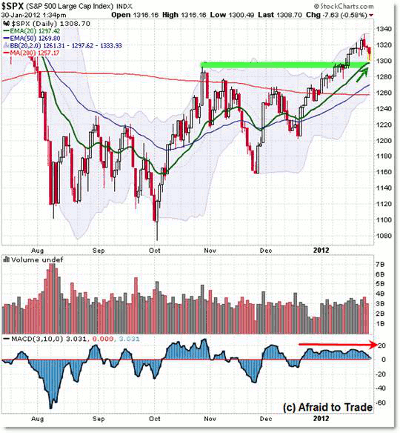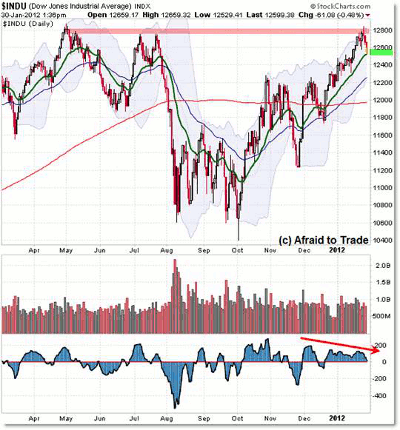The S&P 500 is facing an important test of nearby support while the Dow is squeezed in between support and key resistance overhead, thus forming the basis for trading in these indices this week.
There seems to be a lot more talk in the last few days over the general direction of the markets. Is our short-lived rally over? Should we buy this dip? Let’s see what the charts have to say.
Both the Dow Jones and S&P 500 currently face price challenges at critical levels, particularly the rising 20-day exponential moving average (EMA).
Let’s take a look at the levels to watch and perhaps develop trades on any breakouts from these levels.
First, the simple S&P 500 daily chart:
Removing all other factors, the daily S&P 500 index faces a key support test at the confluence of the rising 20-period EMA (1,297) and round-number 1,300 level.
If buyers step in here, we would be looking for a rally (and trend continuation) into 1,340, and any upward break above the 1,340/1,350 target allows for more room to run to the upside, targeting the 1,375 bull market recovery high last seen in May 2011.
Of course, should buyers fail to support the market at this logical retracement support level, downside targets such as 1,280, 1,260, and perhaps even 1,200 would be favored.
NEXT: Latest Technical Action for Dow Jones Index
|pagebreak|The Dow Jones Index shows a similar support level, but a major resistance level overhead:
The most important thing to me in the Dow Jones chart is not the rising 20-day EMA support confluence, but the huge wall of overhead resistance into the 12,800 level.
In other words, the Dow Jones Index is just a few points away from breaking to new bull market recovery highs above the May 2011 peak (12,876).
For traders, this is a key inflection where something has to give and you can develop trades based on what happens (or more specifically, which price level fails/breaks).
From a logical standpoint, a breakthrough firmly above 12,900 will initially force short sellers to buy back their losing positions, which may join with sidelined buyers who put on fresh new buy positions or else add to existing bullish positions.
That is the logic of positive feedback loops in price, particularly on firm breakthroughs above “obvious” resistance levels.
Of course, a failure to break obvious resistance does not trigger a bullish feedback loop, and instead argues for price to fall lower to test previous support targets, which include 12,300, 12,200, and of course, 12,000 in the Dow Jones.
As short-term (hopefully unbiased) traders, let’s watch these key support and resistance levels very closely this week.
By Corey Rosenbloom, CMT, trader and blogger, AfraidToTrade.com
Corey Rosenbloom will be speaking on this and other topics at the New York Traders Expo.



















